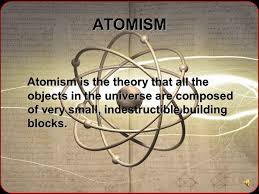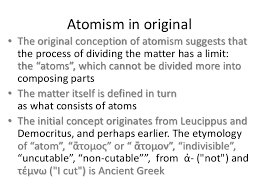By Jacob Bell, Associate Editor, Classical Wisdom
Most folks know something about atomic theory… its surprising ancient history, however, is often less discussed.
The current modern atomic theory is the prevailing scientific theory of matter and explains the physical world in terms of discrete units referred to as atoms. Atoms are made up of various subatomic particles such as electrons, protons, and neutrons.
However, the term “atom” actually comes from the Greek adjective atomos, which means “indivisible.” Like many other modern scientific and philosophical theories, atomic theory has its roots in ancient Greek philosophy.
Leucippus, living in the 5th century BCE, was the founder of atomism. This early account of atomic theory arose in response to Parmenides’ denial of the void. Leucippus claimed that without the void, motion was impossible. He also claimed that equating the void with nonexistence was a false equation.
Leucippus argued that the void existed as empty space and he used this as a foundational assumption in his atomic theory. He went on to expand this notion by insisting that the world was made up of one type of substance, namely atoms.
Leucippus went on to claim that this fundamental substance was infinite in number, indivisible, moved through empty space, and came together in particular combinations which gave rise to the visible objects of the world.
We don’t know much more about this first encounter with atomic theory because we don’t know very much about Leucippus and only have a few surviving fragments of his work.
Fortunately, much more is known about Democritus, who was a prolific writer and student of Leucippus. Democritus lived from 460-370 BCE.
Democritus elaborated on the theory of atoms, could predict weather changes, and dissected various animals throughout his career as a natural philosopher.
Intent on finding wisdom, he spent his entire inheritance traveling and studying. During his travels he visited Egypt, Ethiopia, Persia, and India. When his money ran out, he returned home to Abdera, where his brother took him in.
Democritus was given two rather interesting nicknames: “The Laughing Philosopher,” and “The Mocker.”
His fellow citizens gave him such titles because he would routinely make public appearances in which he mocked, condemned, and laughed about the foolishness and silliness of human affairs.
Despite being given such seemingly unprofessional nicknames, Democritus became well-known for his knowledge of the physical world. He wanted to explain the world in natural terms and without reference to dogmatic mysticism.
In his expansion of atomic theory, he maintained the indivisibility of the atom because he claimed that it would be impossible to divide matter ad infinitum. He argued that each atom has a density that was in proportion to its volume, and he claimed that the void (empty space) was eternal in its existence.
Atoms, for Democritus, are too small for the naked eye to see. They float around the void, consisting of various shapes, and collide into one another.
Maintaining the notion that every physical object is made up of the same stuff, Democritus believed that a type of image must emerge from the combination of atoms which give rise to external objects. This image causes an impression upon our senses, which results in the appearance of the object in question.
Not only is our vision caused by a combination of atoms resulting in the appearance of a physical object, but all of our sensations are the result of atomic combinations. For instance, Democritus claimed that the taste of bitterness is caused by small, angular, and jagged atoms passing over the tongue. In contrast, the taste of sweetness is caused by larger-smoother atoms.
Perhaps most radically, Democritus claimed that the only things that can be said to truly exist are atoms and the void. Everything else that is thought to exist is simply a matter of social convention.
Democritus went on to claim that sensations such as the feeling of hot or cold had no real existence and were simply produced in organisms through a particular combination of atoms moving through the void.
Because we can perceive only the physical conglomeration of atoms that results in a visible physical object or subjective sensation, Democritus claimed that we were incapable of fully understanding the cosmos. There would always be something of which we could not observe, deduce, or understand due to this indirect experience of atoms and the void.
These early conceptions of atomic theory predate our modern theory of the atom by more than 2,000 years. It wasn’t until the 19th century that chemists began to refer to particular irreducible elements as atoms.
The 21st century notion of what an atom consists of is vastly different than that of the ancient Greeks, but that doesn’t diminish what many would claim is a kind of genius that went into developing such a theory.
Leucippus and Democritus were intuitive and wise beyond their years. Like many other Greek philosophers, they looked past tradition and cultural convention, forging their own path and establishing their own worldview. Idyllic in their innovative nature, they remain a great source of inspiration to this very day.













One comment
TENÍA ALGÚN CONOCIMIENTO DE DEMÓCRITO, PERO NO TAN COMPLETO
ISIDRO GARRIDO BERMEJO
Our apologies, you must be logged in to post a comment.